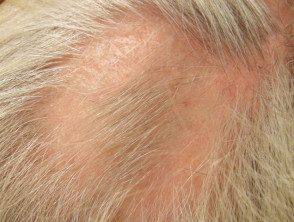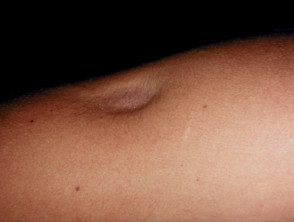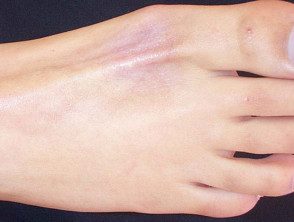What is an intralesional steroid injection?
An intralesional steroid injection involves a corticosteroid such as triamcinolone acetonide injected directly into an injury on or just under the skin.
In New Zealand, triamcinolone injection is marketed as Kenacort-A and is available in 2 strengths: 10 mg per mL (Kenacort-A 10) and 40 mg per mL (Kenacort-A 40). Triamcinolone Acetonide is marketed as Kenalog in the US. Betamethasone Injection is marketed as Celestone Chronodose (1 mL) and is not available in New Zealand.
Shorter-acting corticosteroid preparations, such as dexamethasone or betamethasone acetate, are sometimes given in combination with triamcinolone.
What are intralesional steroids used for?
An intralesional steroid injection may be indicated for the following skin conditions:
- Alopecia areata
- Discoid lupus erythematosus
- keloid/hypertrophic scar
- Granuloma cancel
- Other granulomatous disorders like cutaneous sarcoidosis or facial granuloma
- Hypertrophic lichen planus
- Lichen simplex chronicus (neurodermatitis)
- Located psoriasis
- Necrobiosis lipoidica
- Acne cysts (see nodulocystic acne) and inflamed epidermoid cysts.
- small infant hemangiomas
- Others located inflammatory Skin diseases.
Hair regrowth after intralesional steroids in alopecia areata

Intralesional steroid injection for alopecia areata
What are the benefits of intralesional steroids?
Intralesional administration of corticosteroids treats a dermal inflammatory process directly. In contrast with current steroids, intralesional steroids:
- Avoid the barrier of a thickened stratum corneum
- Reduces the possibility of epidermal atrophy (thinning of surface skin)
- Deliver higher concentrations to the site of pathology.
Other Uses for Triamcinolone Acetonide Injection
Triamcinolone injection is also sometimes used intramuscularly (instead of intralesional injection) systemically as an alternative to oral corticosteroids, for example for seasonal hay feveror to treat a chronic skin disorder like atopic dermatitis or lichen planus.
Typical intramuscular doses are 0.5–1 mg/kg body weight (40–80 mg for a typical adult), which may be repeated every 30 days for 3–6 months.
Triamcinolone injections can also be used in the treatment of tendinitis, arthritisand synovitis.
Which are the contraindications to intralesional steroid injection?
Intralesional steroids should not be injected into the site of active skin. infection (for example, impetigo or herpes simplex).
They should not be used if there is a known triamcinolone allergy.
When large doses of triamcinolone acetonide are used as an alternative to oral steroids such as prednisone, they are considered systemic Steroids should be avoided in patients with the following disorders:
- Active tuberculosis or systemic fungal infection
- Extensive license plate psoriasis, pustular psoriasis or erythrodermic psoriasis: systemic steroids may destabilize psoriasis
- Active peptic ulcer disease
- Uncontrolled diabetes, heart failure or severe hypertension
- Severe depression or psychosis
How is the intralesional steroid administered?
Intralesional triamcinolone is injected directly into the skin lesion using a fine needle after cleaning the injection site with alcohol or antiseptic. solution. The injection must be intradermalno subcutaneous, to avoid causing dents in the skin.
The initial dose per injection site will vary depending on the lesion to be treated. In general, 0.1–0.2 mL is injected per square centimeter of affected skin. The total dose should not normally exceed 1 to 2 ml per dose. It can be repeated every 4 to 8 weeks.
The corticosteroid can be full strength (eg, triamcinolone 10 mg/mL or 40 mg/mL) or diluted with normal saline or local anesthetic. Typical regimens for intralesional triamcinolone injections include:
- 40mg/ml for a thick keloid scar
- 10 mg/ml for a hypertrophic scar of moderate thickness
- 10 mg/ml in discoid lupus erythematosus or granuloma annulare
- 5 mg/mL in normal thickness skin associated with alopecia areata.
The injections may be repeated monthly for a few months while the lesions are active.
Intralesional steroid injection

Intralesional steroid injection

Intralesional steroid injection
What side effects can occur at the site of an intralesional steroid injection?
The side effects and risks of intralesional triamcinolone can be divided into early and late effects.
The first effects tend to be self-limited. They include:
- Pain, bleeding, bruises.
- Infection
-
Allergic contact dermatitis due to the preservative, benzyl alcohol
- Impaired wound healing.
- Sterile abscesssometimes requires surgical drainage.
Late side effects include:
- Cutaneous and subcutaneous lipoatrophy (most common): Indentations or dimpling of the skin around injection sites a few weeks after treatment; these can be permanent
- White marks (leukoderma) or brown markings (post-inflammatory pigmentation) at the injection site or spread from the injection site; these may resolve or persist long-term
- Telangiectasia at the injection site, which can be treated if necessary by To be or intense pulsed light (IPL).
- Located hypertrichosis; this is eventually resolved.
- Localized or distant steroid acne: Steroids increase growth hormone, which increases tallow production by the sebaceous glands Steroid acne usually improves once the steroid has been stopped.
Side Effects of Intralesional Steroid Injection

Lipoatrophy

Leukoderma

Lipoatrophy and leukoderma
Systemic Side Effects of Triamcinolone Injections
Allergic reactions they are very rare and are dose-independent. They may include local or generalized urticaria (bump and outbreak), and in more severe cases, anaphylaxis.
Other systemic side effects are not likely to follow intralesional injection for localized skin disease because the dose used is so small.
The following potentially serious conditions have been reported from intramuscular injection of large doses of triamcinolone acetonide.
- Heart: congestive heart failure in susceptible patients, fluid retention, hypertension, cardiac arrhythmias.
- Hormonal effects: decreased glucose grace, cushings syndrome, hirsutism, hypertrichosis, diabetes mellitus, menstrual irregularities, adrenocortical and pituitary unresponsiveness, and growth suppression in children.
- Musculoskeletal disease: aseptic necrosis of hip or shoulder bones, calcinosis, osteoporosis and pathological fractures, muscle weakness and tendon rupture.
- Neurological /psychiatric symptoms: seizures, depression, euphoria, brain swelling, insomnia, and mood swings.
- Eyes: glaucoma, waterfallsand rare cases of blindness associated with periocular injections.

